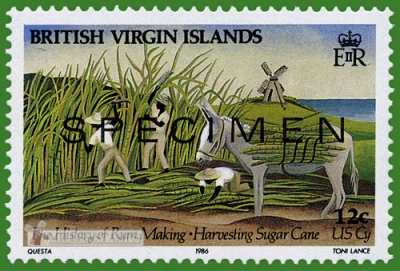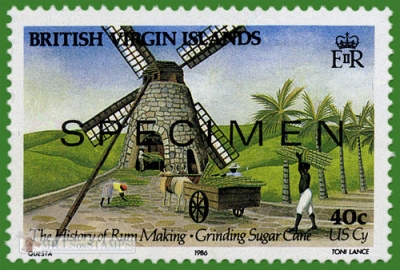-
History of Rum making
British Virgin Islands 1986.07.30
In issue: Stamp(s): 4 Souvenir sheet(s): 1
Printing: offset
-
Number by catalogue: Michel: 555 Scott: 541
Perforation type: 14x14
Subject:
12 cents. Harvesting sugar cane
Topics: Mills within the landscapes Windmills
-
Number by catalogue: Michel: 556 Scott: 543
Perforation type: 14x14
Subject:
40 cents. Transporting and grinding of sugar cane
Additional:
Rum is a distilled beverage made from sugarcane by-products such as molasses and sugarcane juice by a process of fermentation and distillation. The distillate, a clear liquid, is then usually aged in oak and other barrels. The majority of the world's rum production occurs in and around the Caribbean and in several South American countries, such as Colombia, Venezuela, Guyana and Brazil. There are also rum producers in places such as Australia, Fiji, the Philippines, India, Reunion Island, Mauritius, and elsewhere around the world.
Light rums are commonly used in cocktails, whereas golden and dark rums are also appropriate for drinking straight, or for cooking. Premium rums are also available that are made to be consumed straight or with ice.
Rum plays a part in the culture of most islands of the West Indies, and has famous associations with the Royal Navy (See: Grog) and piracy (See: Bumbo). Rum has also served as a popular medium of exchange that helped to promote slavery along with providing economic instigation for Australia's Rum Rebellion and the American Revolution.The precursors to rum date back to antiquity. Development of fermented drinks produced from sugarcane juice is believed to have first occurred either in ancient India or China, and spread from there. An example of such an early drink is brum. Produced by the Malay people, brum dates back thousands of years. Marco Polo also recorded a 14th-century account of a "very good wine of sugar" that was offered to him in what is modern-day Iran.
The first distillation of rum took place on the sugarcane plantations of the Caribbean in the 17th century. Plantation slaves first discovered that molasses, a by-product of the sugar refining process, can be fermented into alcohol. Later, distillation of these alcoholic by-products concentrated the alcohol and removed impurities, producing the first true rums. Tradition suggests that rum first originated on the island of Barbados. Regardless of its initial source, early Caribbean rums were not known for high quality. A 1651 document from Barbados stated, "The chief fuddling they make in the island is Rumbullion, alias Kill-Divil, and this is made of sugar canes distilled, a hot, hellish, and terrible liquor"Unlike some other spirits, such as Cognac and Scotch, rum has no defined production methods. Instead, rum production is based on traditional styles that vary between locations and distillers.
Most rum produced is made from molasses. Within the Caribbean, much of this molasses is from Brazil. A notable exception is the French-speaking islands where sugarcane juice is the preferred base ingredient.
Yeast and water are added to the base ingredient to start the fermentation process. While some rum producers allow wild yeast to perform the fermentation, most use specific strains of yeast to help provide a consistent taste and predictable fermentation time. Dunder, the yeast-rich foam from previous fermentations, is the traditional yeast source in Jamaica. "The yeast employed will determine the final taste and aroma profile," says Jamaican master blender Joy Spence. Distillers that make lighter rums, such as Bacardi, prefer to use faster-working yeasts. Use of slower-working yeasts causes more esters to accumulate during fermentation, allowing for a fuller-tasting rum.
As with all other aspects of rum production, there is no standard method used for distillation. While some producers work in batches using pot stills, most rum production is done using column still distillation. Pot still output contains more congeners than the output from column stills and thus produces a fuller-tasting rum.
Many countries require that rum be aged for at least one year. This aging is commonly performed in used bourbon casks, but may also be performed in stainless steel tanks or other types of wooden casks. The aging process determines the coloring of the Rum. Rum that is aged in oak casks becomes dark, whereas Rum that is aged in stainless steel tanks remains virtually colorless. Due to the tropical climate common to most rum-producing areas, rum matures at a much faster rate than is typical for Scotch or Cognac. An indication of this faster rate is the angel's share, or amount of product lost to evaporation. While products aged in France or Scotland see about 2% loss each year, rum producers may see as much as 10%. After aging, rum is normally blended to ensure a consistent flavor. Blending is the final step in the Rum making process. As part of this blending process, light rums may be filtered to remove any color gained during aging. For darker rums, caramel may be added to the rum to adjust the color of the final product.******
The stamps used as an example are not postal, because on them there is Specimen overprint. In the post reference of stamps was without overprints.
Topics: Windmills



